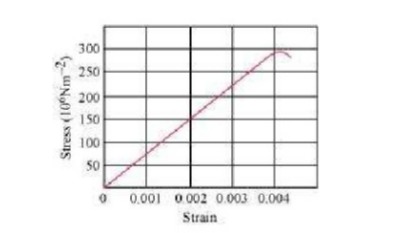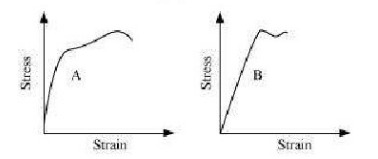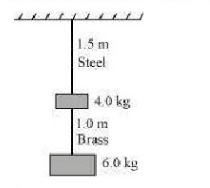NCERT Solutions Class 11 Physics Chapter 9 Mechanical Properties of Solids – Here are all the NCERT solutions for Class 11 Physics Chapter 9. This solution contains questions, answers, images, explanations of the complete chapter 9 titled Of Mechanical Properties of Solids taught in Class 11. If you are a student of Class 11 who is using NCERT Textbook to study Physics, then you must come across chapter 9 Mechanical Properties of Solids After you have studied the lesson, you must be looking for answers of its questions. Here you can get complete NCERT Solutions for Class 11 Physics Chapter 9 Mechanical Properties of Solids in one place.
NCERT Solutions Class 11 Physics Chapter 9 Mechanical Properties Of Solids
Here on AglaSem Schools, you can access to NCERT Book Solutions in free pdf for Physics for Class 11 so that you can refer them as and when required. The NCERT Solutions to the questions after every unit of NCERT textbooks aimed at helping students solving difficult questions.
For a better understanding of this chapter, you should also see summary of Chapter 9 Mechanical Properties Of Solids , Physics, Class 11.
| Class | 11 |
| Subject | Physics |
| Book | Physics Part I |
| Chapter Number | 9 |
| Chapter Name |
Mechanical Properties Of Solids |
NCERT Solutions Class 11 Physics chapter 9 Mechanical Properties Of Solids
Class 11, Physics chapter 9, Mechanical Properties Of Solids solutions are given below in PDF format. You can view them online or download PDF file for future use.
Mechanical Properties Of Solids Download
Did you find NCERT Solutions Class 11 Physics chapter 9 Mechanical Properties Of Solids helpful? If yes, please comment below. Also please like, and share it with your friends!
NCERT Solutions Class 11 Physics chapter 9 Mechanical Properties Of Solids- Video
You can also watch the video solutions of NCERT Class11 Physics chapter 9 Mechanical Properties Of Solids here.
Video – will be available soon.
If you liked the video, please subscribe to our YouTube channel so that you can get more such interesting and useful study resources.
Download NCERT Solutions Class 11 Physics chapter 9 Mechanical Properties Of Solids In PDF Format
You can also download here the NCERT Solutions Class 11 Physics chapter 9 Mechanical Properties Of Solids in PDF format.
Click Here to download NCERT Solutions for Class 11 Physics chapter 9 Mechanical Properties Of Solids
Question & Answer
Q.1: A steel wire of length 4.7 m and cross-sectional area 3.0 × 10-5 \(m^{2}\) stretches by the same amount as a copper wire of length 3.5 m and cross-sectional area of 4.0 × 10–5 \(m^{2}\) under a given load. What is the ratio of the Young’s modulus of steel to that of copper?
Ans : \(\begin{array}{l}{\text { Length of the steel wire, } L_{1}=4.7 \mathrm{m}} \\ {\text { Area of cross-section of the steel wire, } A_{1}=3.0 \times 10^{-5} \mathrm{m}^{2}} \\ {\text { Length of the copper wire, } L_{2}=3.5 \mathrm{m}} \\ {\text { Area of cross-section of the copper wire, } \mathrm{A}_{2}=4.0 \times 10^{-5} \mathrm{m}^{2}}\end{array}\) \(\begin{array}{l}{\text { Length of the copper wire, } L_{2}=3.5 \mathrm{m}} \\ {\text { Area of cross-section of the copper wire, } \mathrm{A}_{2}=4.0 \times 10^{-5} \mathrm{m}^{2}} \\ {\text { Change in length }=\Delta L_{1}=\Delta L_{2}=\Delta L} \\ {\text { Force applied in both the cases }=F} \\ {\text { Young's modulus of the steel wire: }}\end{array}\) \(\begin{array}{l}{Y_{1}=\frac{F_{1}}{A_{1}} \times \frac{L_{1}}{\Delta L}} \\ {=\frac{F \times 4.7}{3.0 \times 10^{-5} \times \Delta L}_{\ldots(i)}}\end{array}\) \(\begin{array}{l}{\text { Young's modulus of the copper wire: }} \\ {Y_{2}=\frac{F_{2}}{A_{2}} \times \frac{L_{2}}{\Delta L_{2}}} \\ {=\frac{F \times 3.5}{4.0 \times 10^{-5} \times \Delta L}}\end{array}\) \(\begin{array}{l}{\text { Dividing (i) by (ii), we get: }} \\ {\frac{Y_{1}}{Y_{2}}=\frac{4.7 \times 4.0 \times 10^{-5}}{3.0 \times 10^{-5} \times 3.5}=1.79 : 1} \\ {\text { The ratio of Young's modulus of steel to that of copper is } 1.79 : 1 .}\end{array}\)
Q.2: Figure 9.11 shows the strain-stress curve for a given material. What are (a) Young’s modulus and (b) approximate yield strength for this material?

Ans : \(\begin{array}{l}{\text { (a) It is clear from the given graph that for stress } 150 \times 10^{6} \mathrm{N} / \mathrm{m}^{2}, \text { strain is } 0.002} \\ {=\frac{\text { Stress }}{\text { Strain }}} \\ {\therefore \text { Young's modulus, } Y} \\ {=\frac{150 \times 10^{6}}{0.002}=7.5 \times 10^{10} \mathrm{N} / \mathrm{m}^{2}}\end{array}\) \(\begin{array}{l}{\text { Hence, Young's modulus for the given material is } 7.5 \times 10^{10} \mathrm{N} / \mathrm{m}^{2} \text { . }} \\ {\text { (b) The yield strength of a material is the maximum stress that the material can sustain }} \\ {\text { without crossing the elastic limit. }} \\ {\text { It is clear from the given graph that the approximate yield strength of this material is }} \\ {300 \times 10^{6} \mathrm{Nm} /^{2} \text { or } 3 \times 10^{8} \mathrm{N} / \mathrm{m}^{2}}\end{array}\)
Q.3: The stress-strain graphs for materials A and B are shown in Fig. 9.12.
 The graphs are drawn to the same scale.
(a) Which of the materials has the greater Young’s modulus?
(b) Which of the two is the stronger material?
The graphs are drawn to the same scale.
(a) Which of the materials has the greater Young’s modulus?
(b) Which of the two is the stronger material?
Ans : (a) For a given strain, the stress for material A is more than it is for material B, as shown in the two graphs. Young's modulus \(\begin{array}{l}{=\frac{\text { Stress }}{\text { Strain }}} \\ {\text { Young's modulus }} \\ {\text { For a given strain, if the stress for a material is more, then Young's modulus is also }} \\ {\text { greater for that material. Therefore, Young's modulus for material A is greater than it is }} \\ {\text { for material B. }}\end{array}\) \(\begin{array}{l}{\text { (b) The amount of stress required for fracturing a material, corresponding to its fracture }} \\ {\text { point, gives the strength of that material. Fracture point is the extreme point in a stress- }} \\ {\text { strain curve. It can be observed that material A can withstand more strain than material }} \\ {\text { B. Hence, material A is stronger than material B. }}\end{array}\)
Q.4: Read the following two statements below carefully and state, with reasons, if it is true or false.
(a) The Young’s modulus of rubber is greater than that of steel;
(b) The stretching of a coil is determined by its shear modulus.
Ans : (a) False (b) True (a) For a given stress, the strain in rubber is more than it is in steel. Young's modulus, \(Y=\frac{\text { Stress }}{\text { Strain }}\) For a constant stress: \(Y \propto \frac{1}{\text { Strain }}\) Hence, Young's modulus for rubber is less than it is for steel. (b) Shear modu us is the ratio of the applied stress to the change in the shape of a body. The stretching of a coil changes its shape. Hence, shear modulus of elasticity is involved in this process.
Q.5: Two wires of diameter 0.25 cm, one made of steel and the other made of brass are loaded as shown in Fig. 9.13. The unloaded length of steel wire is 1.5 m and that of brass wire is 1.0 m. Compute the elongations of the steel and the brass wires.

Ans : \(\begin{array}{l}{\text { Elongation of the steel wire }=1.49 \times 10^{-4} \mathrm{m}} \\ {\text { Elongation of the brass wire }=1.3 \times 10^{-4} \mathrm{m}} \\ {\text { Diameter of the wires, } d=0.25 \mathrm{m}}\end{array}\) \(\begin{array}{l}{\text { Hence, the radius of the wires, }^{r=\frac{d}{2}}=0.125 \mathrm{cm}} \\ {\text { Length of the steel wire, } L_{1}=1.5 \mathrm{m}} \\ {\text { Length of the brass wire, } L_{2}=1.0 \mathrm{m}} \\ {\text { Total force exerted on the steel wire: }} \\ {F_{1}=(4+6) \mathrm{g}=10 \times 9.8=98 \mathrm{N}} \\ {\text { Young's modulus for steel: }}\end{array}\) \(Y_{1}=\frac{\left(\frac{F_{1}}{A_{1}}\right)}{\left(\frac{\Delta L_{1}}{L_{1}}\right)}\) \(\begin{array}{l}{\text { Where, }} \\ {\Delta L_{1}=\text { Change in the length of the steel wire }} \\ {A_{1}=\text { Area of cross-section of the steel wire }=\pi r_{1}^{2}} \\ {\text { Young's modulus of steel, } Y_{1}=2.0 \times 10^{11} \text { Pa }}\end{array}\) \(\begin{array}{l}{\therefore \Delta L_{1}=\frac{F_{1} \times L_{1}}{A_{1} \times Y_{1}}=\frac{F_{1} \times L_{1}}{\pi r_{1}^{2} \times Y_{1}}} \\ {=\frac{98 \times 1.5}{\pi\left(0.125 \times 10^{-2}\right)^{2} \times 2 \times 10^{11}}=1.49 \times 10^{-4} \mathrm{m}}\end{array}\) \(\begin{array}{l}{\text { Total force on the brass wire: }} \\ {F_{2}=6 \times 9.8=58.8 \mathrm{N}} \\ {\text { Young's modulus for brass: }} \\ {Y_{2}=\frac{\left(\frac{F_{2}}{A_{2}}\right)}{\left(\frac{\Delta L_{2}}{L_{2}}\right)}}\end{array}\) \(\begin{array}{l}{\text { Where, }} \\ {\Delta L_{2}=\text { Change in length }} \\ {A_{2}=\text { Area of cross-section of the brass wire }}\end{array}\) \(\begin{array}{l}{\therefore \Delta L_{2}=\frac{F_{2} \times L_{2}}{A_{2} \times Y_{2}}=\frac{F_{2} \times L_{2}}{\pi r_{2}^{2} \times Y_{2}}} \\ {=\frac{58.8 \times 1.0}{\pi \times\left(0.125 \times 10^{-2}\right)^{2} \times\left(0.91 \times 10^{11}\right)}=1.3 \times 10^{-4} \mathrm{m}}\end{array}\) \(\begin{array}{l}{\text { Elongation of the steel wire }=1.49 \times 10^{-4} \mathrm{m}} \\ {\text { Elongation of the brass wire }=1.3 \times 10^{-4} \mathrm{m}}\end{array}\)
NCERT / CBSE Book for Class 11 Physics
You can download the NCERT Book for Class 11 Physics in PDF format for free. Otherwise you can also buy it easily online.
- Click here for NCERT Book for Class 11 Physics
- Click here to buy NCERT Book for Class 11 Physics
All NCERT Solutions Class 11
- NCERT Solutions for Class 11 Accountancy
- NCERT Solutions for Class 11 Biology
- NCERT Solutions for Class 11 Chemistry
- NCERT Solutions for Class 11 Maths
- NCERT Solutions for Class 11 Economics
- NCERT Solutions for Class 11 History
- NCERT Solutions for Class 11 Geography
- NCERT Solutions for Class 11 Political Science
- NCERT Solutions for Class 11 Sociology
- NCERT Solutions for Class 11 Psychology
- NCERT Solutions for Class 11 English
- NCERT Solutions for Class 11 Hindi
- NCERT Solutions for Class 11 Physics
- NCERT Solutions for Class 11 Business Studies
- NCERT Solutions for Class 11 Statistics
All NCERT Solutions
You can also check out NCERT Solutions of other classes here. Click on the class number below to go to relevant NCERT Solutions of Class 1, 2, 3, 4, 5, 6, 7, 8, 9, 10, 11, 12.
| Class 4 | Class 5 | Class 6 |
| Class 7 | Class 8 | Class 9 |
| Class 10 | Class 11 | Class 12 |
Download the NCERT Solutions app for quick access to NCERT Solutions Class 11 Physics Chapter 9 Mechanical Properties Of Solids. It will help you stay updated with relevant study material to help you top your class!
The post NCERT Solutions for Class 11 Physics Chapter 9 Mechanical Properties of Solids appeared first on AglaSem Schools.
from AglaSem Schools https://ift.tt/32RqCu0
https://ift.tt/3vkMmuh https://ift.tt/3vkMmuh
















إرسال تعليق